This has been an exciting winter on the Resaca.
Our little horseshoe lake, as the map calls it, has attracted new visitors.
Last year, an Osprey moved in. He’s commandeered a wonderful perch on a dead branch of a huge mesquite tree between the driveway and the Resaca. On sunny days, I see him fly past the kitchen windows around 7 a.m. On grey days, he hangs around and sits for photo sessions.
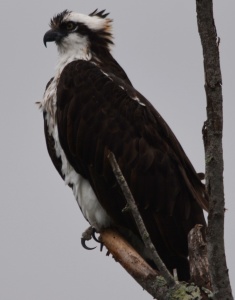
Osprey, Pandion haliaetus, eat mainly fish. They dive into the water from 30-100 feet above the surface. Their claws are curved into one-third of a circle. Quite cleverly, they carry their prey with the fish head pointing forward to decrease wind resistance, according to my bird book.
In January, another intriguing site captured my attention. The post that generally belongs to our resident Neotropic Cormorant, Phalacrocorax brasilianus, had an odd-looking cormorant grooming itself. I kept seeing a flash of white.
“Whaaaaat?” I thought and immediately grabbed my camera. Something new had taken the cormorant’s post. A quick snap for identification purposes. Could it be . . . ? YES! An anhinga!
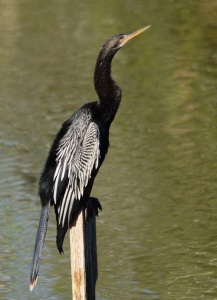
Do you ever go through a bird book or plant book and with a pang of sadness know you’ll probably never see some of those things in real life? Anhinga was one of the birds I thought I’d never see. But now, we have one on the Resaca! Wishful thinking sometimes pays off.
Anhinga, Anhinga anhinga, is in the Anhingidae family. Cormorants are in the Phalacrocoracidae family. Amazingly, not even cousins.
Although their body structure looks similar to a cormorant’s, the anhinga’s bill and feet are different and the neck is longer and thinner. Silver-white streaks and spots are visible on their upper back and forewings. The tail has a buff-colored band at the tip.
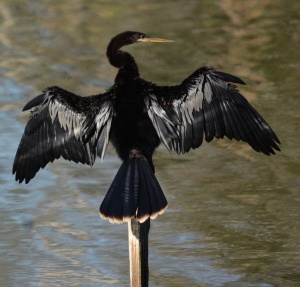
So, if that wasn’t exciting enough, a week later our small Resaca was visited by a squadron of white pelicans, Pelecanus erythrorhynchos. They swooped in, landed on the water and, en masse, traversed the entire rim of the Resaca.
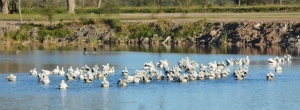
As awesome as it was, I couldn’t help thinking about the number of fish they were devouring and hoped this was just a stop-in for breakfast on their way elsewhere, which actually was the case.
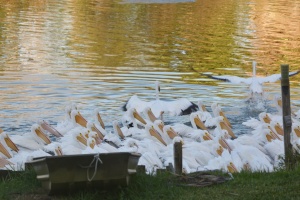
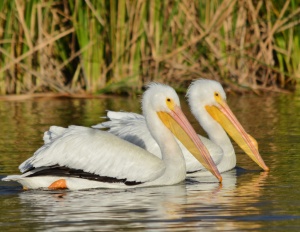
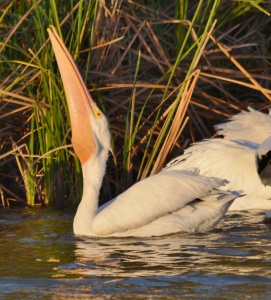
According to my bird book, “an entire flock may work communally to catch fish by herding them into an enclosed area then scooping the fish out of the water with pouches that can hold up to 3 gallons of water.”
Our resident cormorant took advantage of the fish corralling and snagged a lovely catfish for breakfast.
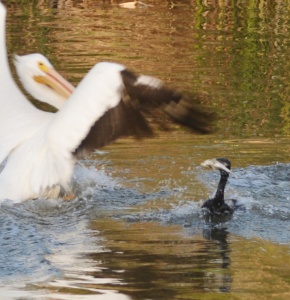
My one-bird-book-knowledge is generally enough for me on a home-on-the-Resaca level.
However, for a more in-depth read about birds and local native habitat, I’d like to bring your attention to one of our new members currently in this year’s training class.
Javier Gonzalez, who goes by Javi, writes a monthly column called “Life on the Boardwalk” that’s published in the South Padre Parade.
Javi is the resident Naturalist Educator at the South Padre Island Birding and Nature Center. He grew up in McAllen, received a degree in biology from University of Texas, Pan-American (now UTRGV) and hired on with the nature center last July.
His most recent article, entitled “Getting Through the Winter,” gives some fascinating information about how birds keep warm. All his articles are packed with information and something to look forward to around the middle of each month.
Good job, Javi, and welcome to our chapter.
The weekly South Padre Parade magazine is a free publication available at newsstands, restaurants and as an insert in some Valley newspapers. RGVCTMN member Marilyn Lorenz and her husband contribute excellent birding stories and photographs to the publication as well.
